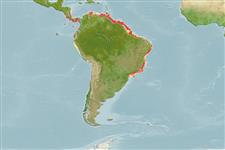Environment: milieu / climate zone / depth range / distribution range
Écologie
marin; eau douce; saumâtre; profondeur 1 - 55 m, usually 5 - 30 m (Ref. 9298). Tropical; 14°N - 26°S, 87°W - 32°W (Ref. 189)
Western Atlantic: Panama to Trinidad and south to at least Santos, Brazil, perhaps further. Eastern Pacific: Costa Rica to the northern border of Peru at 3°34'S, perhaps further. Also found in freshwater.
Taille / Poids / Âge
Maturity: Lm ? range ? - ? cm
Max length : 24.0 cm TL mâle / non sexé; (Ref. 5217); common length : 20.0 cm TL mâle / non sexé; (Ref. 5217); poids max. publié: 66.30 g (Ref. 118626)
Épines dorsales (Total) : 0; Épines anales: 0; Rayons mous anaux: 31 - 37. Snout about 3/4 eye diameter; maxilla long, tip pointed, reaching to or a little beyond edge of gill cover; anterior gill rakers mere stumps; hind border of gill cover with a small triangular projection; panamensis-type gill cover canals. Pectoral fin long; anal fin origin below midpoint of dorsal fin base. A silver stripe along flank in small individuals, disappearing with age (Ref. 189).
A coastal species that apparently forms large schools. Enters brackish and fresh waters. Feeds on small fishes (including clupeoids) and prawns (Ref. 12225). Seems to spawn over an extended period in Costa Rica (small fishes caught in February, September and October). Marketed fresh (Ref. 9298).
Life cycle and mating behavior
Maturité | Reproduction | Frai | Œufs | Fécondité | Larves
Probably an extended spawning season in Costa Rica (small fishes caught in February, September and October (Ref. 189). Spawn in school (Ref. 205).
Whitehead, P.J.P., G.J. Nelson and T. Wongratana, 1988. FAO Species Catalogue. Vol. 7. Clupeoid fishes of the world (Suborder Clupeoidei). An annotated and illustrated catalogue of the herrings, sardines, pilchards, sprats, shads, anchovies and wolf-herrings. FAO Fish. Synop. 125(7/2):305-579. Rome: FAO. (Ref. 189)
Statut dans la liste rouge de l'IUCN (Ref. 130435: Version 2024-1)
Menace pour l'homme
Harmless
Utilisations par l'homme
Pêcheries: intérêt commercial mineur
Outils
Articles particuliers
Télécharger en XML
Sources Internet
Estimates based on models
Preferred temperature (Ref.
123201): 25.2 - 28.2, mean 27.4 °C (based on 122 cells).
Phylogenetic diversity index (Ref.
82804): PD
50 = 0.5000 [Uniqueness, from 0.5 = low to 2.0 = high].
Bayesian length-weight: a=0.00457 (0.00297 - 0.00704), b=3.17 (3.05 - 3.29), in cm total length, based on LWR estimates for this species & Genus-body shape (Ref.
93245).
Niveau trophique (Ref.
69278): 4.1 ±0.71 se; based on food items.
Résilience (Ref.
120179): Haut, temps minimum de doublement de population inférieur à 15 mois (Preliminary K or Fecundity.).
Fishing Vulnerability (Ref.
59153): Low vulnerability (14 of 100).
Nutrients (Ref.
124155): Calcium = 188 [109, 440] mg/100g; Iron = 1.38 [0.74, 2.46] mg/100g; Protein = 17.8 [15.4, 20.5] %; Omega3 = 0.338 [0.163, 0.725] g/100g; Selenium = 40.5 [18.0, 103.2] μg/100g; VitaminA = 19.3 [5.6, 54.8] μg/100g; Zinc = 1.51 [1.04, 2.18] mg/100g (wet weight);
